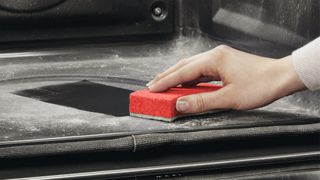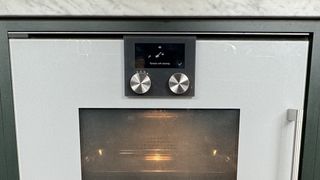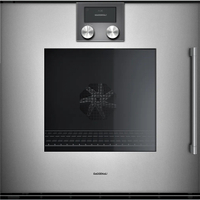‘What I wish I had known before buying a self-cleaning oven’, reveals a kitchen design expert
Cleaning hack of the century or too good to be true? Find out, as I dish the dirt on self-cleaning pyrolytic ovens


Pyrolytic cleaning has been hailed a modern housework hero, ending the torturous task of scrubbing out greasy ovens forever. Once you’ve owned an oven with that magic pyrolytic button, I’ll bet my firstborn’s life you’ll never even look at one without it again.
In my job as a journalist specialising in kitchen trends, I tend to hear about kitchen appliance trends and innovations before they are launched. When I first heard whispers about self-cleaning ovens that required almost zero human interaction, the excitement was real.
The technology was invented in the ‘70s but didn’t really take off until about 20 years ago when it became more affordable and more widely available. Fast forward to 2016, when I finally got the opportunity to own a pyrolytic oven to revolutionise cleaning the kitchen.
My previous homes had come with perfectly acceptable ovens that didn’t deserve to be in a landfill, but when we moved to our current home the cooker in-situ was a fire hazard waiting to happen. I couldn’t get on the phone to my nearest Gaggenau dealer faster! I wanted the best German brand I could afford, and it had to have pyrolytic (the model we chose is from the 200 Series).
Since then, I’ve never had to get down on my hands and knees to scrub an oven, and I am delighted with my good luck (and maybe a little smug, sorry). Although I knew how the pyrolytic process worked in theory, I didn’t really dare to believe it would allow me to bin the Marigolds and never have to even think about how to clean an oven ever again.
If you’re tempted by pyrolytic tech, and you should be, read on for my insight into the pros and cons.
What you need to know before buying a pyrolytic oven
If you don’t know how pyrolytic ovens work, it’s quite interesting (at least for kitchen nerds like me!). "Pyrolytic cleaning works by raising the internal temperature of the oven to the extremely high level of 475-485°c. This intense heat causes any grime, whether hidden or baked-on, to carbonise into a fine ash," explains Luke Shipway, head of product at kitchen designers Caple.
Sign up for the woman&home newsletter
Sign up to our free daily email for the latest royal and entertainment news, interesting opinion, expert advice on styling and beauty trends, and no-nonsense guides to the health and wellness questions you want answered.
"Once the cleaning cycle is complete and the oven has cooled down, this ash can be easily wiped away for effortless cleaning. This process eliminates the need for harsh chemicals or scrubbing, making it a convenient and efficient way to keep your oven clean and hygienic," adds Luke.
While the pyrolytic concept is the same no matter which oven you buy, some models offer different cleaning programmes and features. Naturally, pyrolytic cleaning is only one aspect of choosing an oven, so you’ll also need to consider what other functionality, such as air-frying programmes or built-in probes, you require.
However, for the purposes of this article, I am only looking at self-cleaning pyrolytic, and these are the key points you need to consider.

With more than 21 years at Caple, Luke has covered various departments including sales, purchasing, and product management before ascending to the position of Head of Product. His extensive experience and commitment to excellence have been instrumental in shaping Caple's innovative appliance solutions.

The easy task of cleaning ash out of a self-cleaning pyrolytic oven
CLEANING OPTIONS
My oven only has one pyrolytic cleaning option, which is intensive and takes no prisoners. However, many newer models now come with multiple choices, from a quick blast for light residue, a slightly longer cleaning cycle for medium dirt levels, to a full-on ‘you’ve left it too long’ intensive clean that takes about two hours.
Whether or not you need more flexibility with your pyrolytic cleaning comes down to your dirt tolerance levels and how often you feel you should clean an oven.
Because my oven takes so long to self-clean, I tend to leave it as long as possible between cleans. But if I did have the option to do a quicker blast that keeps the grease levels under control, would I bother/remember to do so? Probably not.
ENERGY CONSUMPTION
When you’re heating an oven up to 500°c for several hours, it’s hard not to worry about the state of your electricity bill and this is one of the reasons I leave mine longer than recommended between cleans. Once a month is suggested for the average four-person household, I probably do it twice a year.
Admittedly it’s hard to argue that pyrolytic cleaning isn’t going to cost you more in electricity, there are other factors to consider that can offset running costs. The main one is that pyrolytic ovens tend to be more energy efficient overall because they need serious layers of insulation to prevent the exterior from becoming dangerously hot.
Most pyrolytic ovens are rated A++ or A+++ for energy, which means you’ll be making energy savings every time you cook, compared to an oven with a lower rating – I found similar when researching what you need to know before buying an induction hob.
Pyrolytic cleaning is completely chemical-free, so you can also offset the cost of cleaning products.
"A basic 90-minute pyrolytic clean on an A++ oven costs just £1.22, based on 47p per kW," according to Natasha Sweet, head of product line (Taste) at AEG. Even if you were doing a longer three-hour cycle, it would only cost £2.44 in energy, which is less than the price of most oven cleaning products and significantly cheaper than getting a specialist firm in.

With a passion for product innovation, Natasha plays a vital role in ensuring AEG’s products exceed customer expectations in technological innovation, design and sustainability.
SAFETY
With two (then young) children in residence, safety was one of my concerns before buying my pyrolytic oven, but I needn’t have stressed.
"During the cleaning process, a door safety lock is activated to prevent users from opening the oven until the temperature inside has cooled down sufficiently," explains Luke Shipway of Caple. "This ensures that users are not exposed to potentially high temperatures that could cause burns or other injuries."
I’ve tried and it’s impossible to override the lock function until it’s safe to open the door. The oven door itself is also safe to touch thanks to triple or even quadruple glazing (depending on which oven you buy). Mine is triple, and while I wouldn’t want to hold my hand on it for long in pyrolytic mode, I can touch it without getting burnt.
It’s also worth noting that pyrolytic cleaning eliminates the need for harsh oven-cleaning products that contain hazardous chemicals or emit harmful fumes. "It’s perfectly safe to be in the home while your oven is self-cleaning and even pets can stay indoors," says Sophie Lane, product training manager, Miele GB. "Pyrolytic cleaning is also great for allergy sufferers or those who are sensitive to strong cleaning products."

Sophie has been working with Miele for more than 10 years and has an in-depth knowledge of all the latest appliance technology. Her product know-how is invaluable when training consumers in the many features of Miele’s extensive range of high-end German appliances.
COSTS
There’s no escaping the fact that pyrolytic ovens cost more than ovens without this functionality. This is mainly because it is more expensive to make a pyrolytic oven due to the advanced technology and extra insulation required, but also because it’s still considered a luxury feature, so tends to be included on top-spec models.
Prices have been dropping in recent years and you can now pick up a basic model for less than £250 like this Hoover H-OVEN 300 HOC3UB5858BI Built In Electric Single Oven with Pyrolytic Cleaning priced £239 at ao.com.
What I wish I had known before buying a pyrolytic self-cleaning oven?
Now we’ve drilled down on the basics of buying a pyrolytic oven, it’s time to dig up the dirt and reveal some of the less appealing truths so you get the full picture before you invest. Similar to what you need to know before buying a boiling water tap, there are pros and cons to consider.
None of them were game over for me, the pros definitely outweigh the cons in my eyes, but these are a few things I wish I had known before buying a pyrolytic oven...
1. They make your kitchen incredibly warm

I mean, it’s obvious now I think about it, but I do recall being shocked by how hot it got in our kitchen the first time I ran the pyrolytic clean. Handy when looking for ways to keep the house warm in winter but otherwise it can be problematic.
In summer months you can just swing the doors open, but in winter it’s worth turning off any radiators or underfloor heating in the kitchen before you begin. Or just vacate the premises.
2. They don’t clean everything
One thing you really do need to take note of when choosing a pyrolytic oven is whether or not the racks and runners need to be removed before you run the cleaning programme.
In my oven the side racks (that hold the shelves in place) and enamelled oven trays are pyrolysis-proof but the shiny steel wire rack will become tarnished if you leave it inside.
As I am lazy and don’t want to manually soak and scrub, I have chosen to embrace the tarnished look, and it doesn’t affect use or longevity. If you like shiny steel racks, take them out and get scrubbing to clean oven racks the traditional way.
They also don't clean the oven seals, so you'll need to get your Marigolds off there, or the front of the oven of course.
3. It can take a long time

And we mean looong time. Cleaning your oven manually probably takes an hour max, allowing 30 minutes for whatever you're soaking it in to work. (We can highly recommend cleaning an oven with baking soda for a natural approach). Most intensive pyrolytic cleaning programmes take three hours to complete.
Even when the cleaning process is over it can take at least another half an hour before you can open the door, as the safety lock won’t release until the temperature drops below 200°c.
Still, you don’t have to be involved in any way, shape or form, so the time it takes doesn’t really matter. You just have to think ahead and make sure you do it when you know you’re not going to want to cook for a while.
Miele’s Sophie Lane recommends starting the pyro programme straight after you’ve finished cooking, which hadn’t occurred to me before but it’s a great tip. ‘The residual heat will help to reduce the amount of energy needed to reach core temperature,’ she explains.
4. They can make the air a bit smitchy
While most oven manufacturers will assure you that pyrolytic cleaning doesn’t release dangerous toxins into the air, and they may well be right, the atmosphere can definitely get hazy. In Devon, we call it smitchy, but that might not be a universal term!
This is especially true if, like me, you’re a bit slack about running the programme and have let the oven get a bit too greasy. User error then. In this instance, I find it helps to run the extractor fan during the pyrolytic process.
If you have one of the best air purifiers handy it pays to run them simultaneously.
5. They can catch on fire
Now this hasn’t happened to me, but I have heard of it happening and the user manual for my oven includes a ‘risk of fire’ warning.
There are two potential fire starters. One can occur if you leave big lumps of food residue or pools of grease and meat juices in your oven before cleaning. ALL pyrolytic oven cavities should be wiped over to remove such hazards before initiating a clean. I use a couple of sheets of kitchen roll to mop up any big spills, which is super quick and seems to do the job.
The second fire hazard may happen if you hang combustible items like tea towels or oven gloves on the door handle during the cleaning cycle. Basically, don’t leave anything touching the glass when your oven’s interior is cranking up to 500°c.
Is there a downside to pyrolytic ovens?
Although pyrolytic ovens are labelled self-cleaning, it’s not entirely true. Oven manufacturers still recommend you clean away any obvious spills after you finish cooking, every time. When the pyrolytic process is complete, your oven interior is coated in a fine cloud of grey ash. It’s super easy to wipe away with a damp cloth but, if your oven is installed in an island unit like mine, you’ll need to get down on your knees to reach right into the back.
I’ll take a ‘light wipe’ over manicure-trashing, sweat-inducing, angry scrubbing any day of the week. One of my absolute favourite things about pyrolytic cleaning is the sheer satisfaction of wiping away that dust to reveal a pristine clean interior.
Honestly, it’s box-fresh every time, which is something I’ve never managed to achieve using sheer elbow grease alone. If you’re in the market for a new oven, I can wholeheartedly recommend you make it a pyrolytic one.
Professional advice and first-hand expertise are invaluable when buying a pyrolytic oven because, unlike asking what you need to know when buying an air fryer or what to know when buying a dehumidifier, a pyrolytic oven is more of an investment due to the higher price point.
I’ve always hated cleaning the oven – it’s got to be one of the least appealing aspects of adulting. And I’m not alone. According to a survey by AEG, cleaning the oven is the most disliked household chore, loathed even more than cleaning out the food waste bin, dusting skirting boards and scrubbing inside the freezer. Consider it done with one of these modern self-cleaning ovens.

An interiors journalist for more than 20 years, Linda Clayton has worked on a wide array of consumer titles, including Homes & Gardens, Livingetc, Country Homes & Interiors and Real Homes.
She graduated from Cardiff’s esteemed School of Journalism, Media and Cultural Studies with a First Class degree and Postgraduate Diploma in Magazine Journalism.
-
 Mesmerising lodges, villas, and courtyards for world-class design inspiration
Mesmerising lodges, villas, and courtyards for world-class design inspirationBookmark these photogenic hideaways for trips to come...
By Lydia Swinscoe Published
-
 All the times the royal women showed us how to look stylish at church
All the times the royal women showed us how to look stylish at churchFrom Queen Camilla to the Princess of Wales, these are the times the royal ladies showed us how to look stylish at church...
By Lauren Clark Published
